When categorizing intuition about the real economy, it is often regarded as a combination of both structural and now cyclical problems. There was, as yet, no true recovery owing largely to factors that continue to linger beyond historical comparisons about what “should” have occurred in and after the Great Recession. Some economists refer to deleveraging especially of households as that primary structural problem, but it is first debatable whether deleveraging has even occurred and secondly that any such trends may more readily be attributed as symptoms of something else entirely.
I think it is actually a mistake to try to separate these trends, as they amount to a large and overarching supercycle. The lack of recovery in the US and the rest of the world is indistinguishable, in terms of causation, from any turn toward darker cyclicality in 2015; even including potential recession. The dominant feature of the supercycle has been chronic instability in economic form. Recession would just be the most severe of those kinds of expressions.
If there is indeed a supercycle at work, then it must be conveyed under some unifying format or system of conduct. Should it exist, we should be able to easily locate its source or main form of manifestation. And it think that is the case as the recent Chinese struggles so helpfully illustrate. The supercycle is the rise and fall of the “dollar.”
I don’t mean that in the respect of the dollar as the denomination of the world’s reserve exchangeability, but rather in the exact methodology of how that has taken shape since the final end of the gold era in 1971 (the gold era actually ended long before that, closing the “gold window” was just the last step in a process that actually dated to the 1950’s). What took over has been expressed as the petrodollar standard, but that elevates the oil producing nations to what I think is an unearned pedestal – if there is a pedestal in this global financial arrangements it is not OPEC accounts it is the eurodollar banks, largely in London, that service them.
Even that word, “service”, is quite misleading in terms of the modern “dollar” framework. In one sense, yes, eurodollar banks offer services but it is the measure of those services that proves this distinction. In global exchange there is no money, which would require service almost exclusively, nor even much of currency; there is only debt. To which the eurodollar system purposefully eschewed any sense of deposits, favoring instead just numbers on ledgers, preferably larger and larger. It was the birth, rise and eventual domination of the wholesale funding model, covering the entire world if only slowly at first.
The height of that system is explicitly evident in the Chinese figures shown above, and they are not limited to just industrial production. The apex of the eurodollar system took place around July 2007, and the fact that we can date that exactly tells you almost everything you need to know about economic insufficiency in the years following it.
There are so many misconceptions about the eurodollar system that it is actually unsurprising that this has gone unappreciated for so long; hell, even Alan Greenspan and Ben Bernanke are still clinging to some ghostly (and ghastly) “global savings glut” and they are supposed to be the smartest and most capable central planners around, given almost godly deference by everyone from the totality of the media to both parties of political authority to even the public that somehow has forgiven (or forgotten) the serial bubbles attached to it all. To uncover the eurodollar rise and now fall is to just recognize something hiding in plain sight.
The TIC data provided by the US Treasury, for example, actually shows us some of the internal function of the eurodollar system even though most convention about this “flow” is totally wrong. You hear it all the time about how the US merchandise trade deficit “feeds” this recycling of trade dollars into foreign buying of dollar-denominated assets. If that were true, then this process would not so neatly cleave right at August 2007, nor would it so snuggly fit the profiles of every “dollar” problem in finance that has occurred since.
That is the structural reality of this supercycle, in that the recurrence rate of “dollar” problems has far, far outpaced all expectations. That is especially true as it goes directly against the grain of conventionally-accepted notions of the healing and even booming economy. Supposedly, the global economy is getting much better and more firmly planted yet the incidence of “dollar” irregularities has increased in frequency and magnitude. That observation is most clearly demonstrated in the accumulations of “dollar” flow in the TIC series (immediately below).
With that overriding framework in place, the various “cyclical” episodes make more sense. The greater the weakness in that overall systemic output, the more susceptible it is to smaller swings in sentiment or whatever. That isn’t a factor of highly complex finance or computer simulations made out of ridiculous regressions, that is just common sense that cuts through all of those complexities that are in some ways nothing but redundant. The fact of the “dollar” system in 2015 is that it has ebbed substantially to a low point that makes dangerous instability the dominant feature.
That is, after all, what the “rising dollar” has told us since late June. While economists talk about the “strong dollar” they do so and simply confirm how little they know about what they speak and write (a truly strong dollar applied to convertibility, and thus was a feature of stability in the US economy and financial system; what we have now even in the “rising dollar” is another form of instability). In the context of the eurodollar system, and how that is organized into the “global dollar short” (short referring to a synthetic short position on the “dollar”), the increase in the relative “price” is that synthetic short becoming more problematic and costly.
It needs to be pointed out that this is not a deficiency in terms of quantity, indeed quantity is a factor that doesn’t much apply in this world and suggests pathology about the failure of quantitative easing to even so much as dent this crumbling inclination. Where there is a shortage is in the means of transference and the willingness to do so – flow. There are any number of elements by which that negative pressure can be expressed which further complicates direct interpretation, so it sometimes better left as a generic catch-all of “bank balance sheet capacity” with an eye toward rounding out those contours where it all possible.
The “global dollar short”, then, should be measured somewhere in terms of bank balance sheet contraction (reformulation or re-allocation might be more appropriate descriptions, but that does not rule out contraction altogether) and not just in the indirect notion of the hugely imbalanced and unstable “dollar” exchange. If you are short a stock, for example, and State Street (the largest bank that hypothecates shares) calls it back you have to buy the stock somewhere to cover your short; if State Street calls a lot of that same stock across the entire market, then the price of the stock shoots upward in a short squeeze. That is essentially what happened in the “dollar”, though we don’t know exactly who is acting as State Street nor in what capacity are they “calling in” funding. The possibilities are enormous, including not just repo illiquidity but IR’s and futures extensions.
What TIC does is provide an estimate of banks’ reported dollar liabilities, which is not a comprehensive estimate but instead a partial window into that process. That the flows in this measure line up closely with observed disorder in the “dollar” world only suggests that it has some relevance to these features.
Since June 2014, the change in banks reporting of “dollar” liabilities has been one of the largest declines in the series, a fact that is actually repeating what happened in 2013 with the difference now of sinking so much further downward. The behavior of bank liabilities here, and of asset prices, generically, by extension, is tuned to central bank policy.
What that shows is the fatal flaw, fatal conceit really, of what the Federal Reserve and its global counterparts have been trying to accomplish. They are still attempting to reconstruct the global financial arrangements, and thus the global economy, as it existed prior to August 2007. The decay, even mimicking almost entropy, of the eurodollar system ultimately means that is a futile effort; which is why there is this stop-go pattern in what banks are doing “contracting” and “expanding” into the “global dollar short.” The most that can be said of all the QE’s and ZIRP, and the little other pieces along the way, is that they provide temporary cover from the direct effects of this supercycle.
Nothing is ever permanent with the QE’s because they were doomed from the start. The “dollar” system can never be refined and remade to its prior station because it was irrevocably broken on August 9, 2007. So the mini-cycle swings in the QE’s are not definitive of themselves because they operate within that governing dynamic, insufficient not in size or quantity but in conduct and even theory to break out of the downswing in the supercycle. All that QE’s have done is to create reverberation within the downward channel which may, in the end, only exacerbate the degree of imbalance that weighs on the inevitable shift.
I have maintained since 2013 that there is an obvious asymmetry to these swings since that point, and this supercycle idea seems to offer correlation if not confirmation. The closer and more tightly wound on the downside of that supercycle, the more exaggeration there is to be in any seemingly minor shifts. That is observable not just via TIC “flows” but in repo mechanics and swap spreads, eurodollar futures and emerging market currencies. Again, there is not much of a mystery here, as any kind of decay is really the idea of greater and greater instability being carried out. The “rising dollar” is exactly that, and there is at least some direct evidence for it. Worse, economic accounts so far in late 2014 and now 2015 more than suggest that is true not just for the “dollar” supercycle but the actual real economic version that so clearly and globally accompanies it.

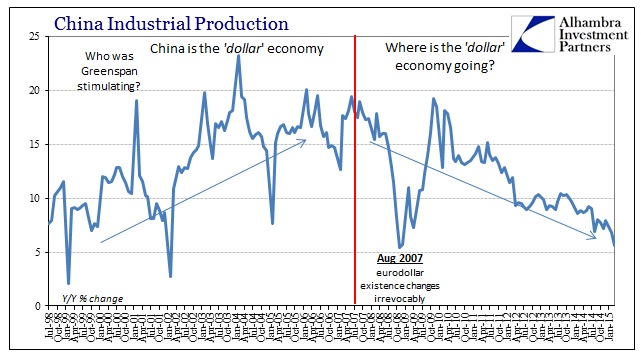
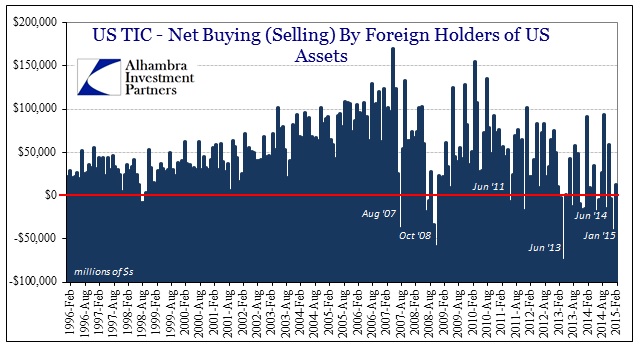
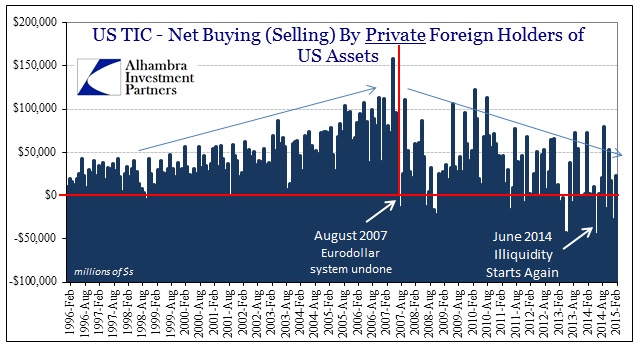
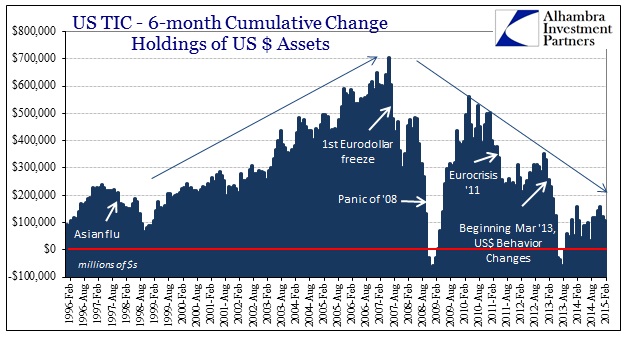

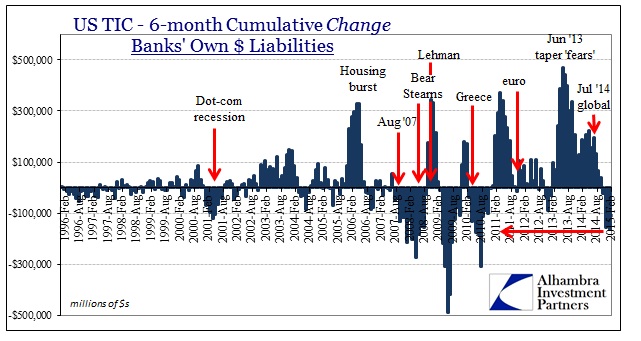
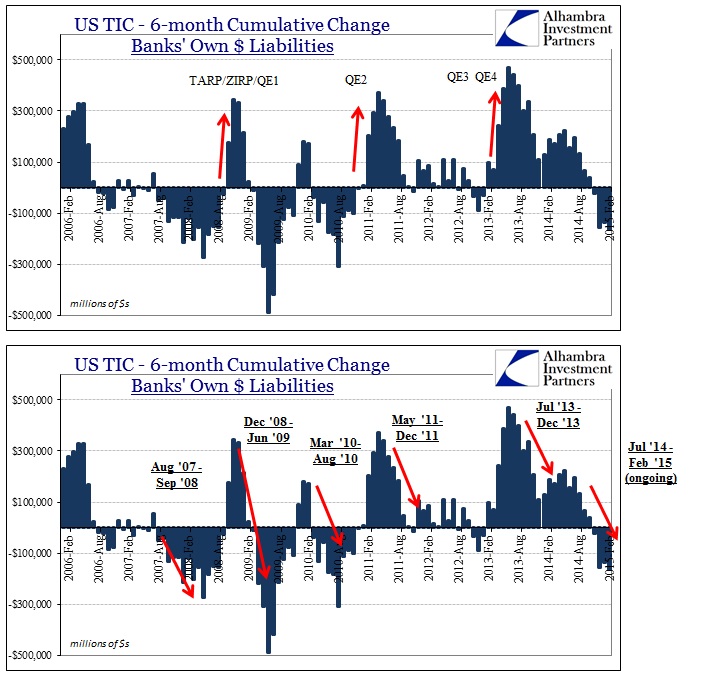
Stay In Touch